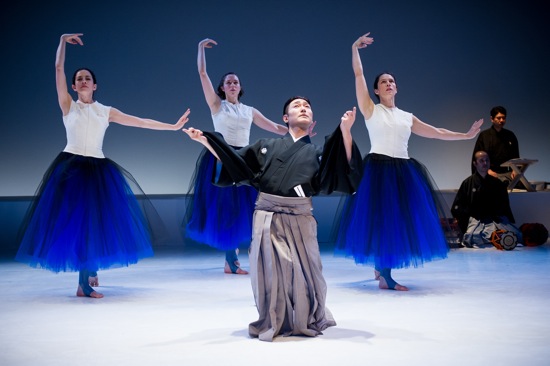
Kuniya Sawamura and (L to R) Jennifer Lafferty, Lindsay Clark, and Julie Alexander in Yasuko Yokoshi’s Bell. Photo: Ian Douglas
Three barefoot women wearing long, deep-blue tutus; tight, white blouses; and blue stirrup socks confront a visitor. She is spectacularly attired in an embroidered kimono over a red velvet garment that terminates in pantlegs so full that they look like a skirt. Her wig is red and so is her lipstick. She has entered with the tiny, smooth steps of a Japanese Kabuki performer; the women in tutus have previously sprinted about the stage doing buoyant, soft-edged ballet steps to some of Adolphe Adam’s music for Giselle. However, Julie Alexander, Lindsay Clark, and Jennifer Lafferty aren’t impersonating the ballet’s heroine or its baleful, Act II ghosts now; they are standing in for the gate-keeping monks at Dojoji Temple in an ancient Japanese drama. They address the visitor (Yasuko Yokoshi) in English in a not unfriendly way, posing questions she’s supposed to be able answer. She replies to each in Japanese. They confer: yes, she got that one right.
The matter-of-fact mingling of languages and styles provokes laughter in the audience. The glamorous visitor seems to ignore the final question. The women’s reaction? “She is so deep!” They allow her to enter the temple precincts, taking her up on her offer to dance in honor of the dedication of a new temple bell. Bad move.
Since 2003, Yasuko Yokoshi has created several works that interweave Japanese traditions she was born into—and which she has since studied—with postmodern structural devices and performance styles. This latest, Bell, shown at New York Live Arts (March 16 and 19-23) is the most ambitious—a shimmering web of cultural confusions.
Yokoshi intends the material that she has drawn from the 1841 Giselle to help a western audience understand Kyôganoko Musume Dôjôji, a 10th-century tale that became an 11th-century Noh play and then an 18th-century Kabuki dance-drama. What do the two tales have in common? A heroine who appears as a ghost, supernatural women seeking vengeance on men who betrayed them, and a bell. Both present distanced ideals of beauty relevant to the culture that produced them.
For Giselle, the church bell that rings at dawn sends her and her fellow Wilis back to their graves; by her dancing interventions she has bought time for her faithless but repentant lover and saved him from having to dance to death. For Hanako, the name assumed by the ravaging spirit disguised as a dancing girl, the bell has darker meanings. As Kiyo-hime, she had fallen in love with a Buddhist priest vowed to celibacy. Enraged by his resistance to her, she changed into a fire-breathing serpent and pursued him; the monks lowered the temple bell over him, but she melted it with her breath, burning him to death. That’s the back story, which Yokoshi tells at the outset of Bell in projected text.
Years later, the temple has gotten a new bell and is celebrating its installation. The jilted stalker’s rage is still intense. Disguised as a shirabayoshi, a female court entertainer, she becomes more and more furious as she performs various dances for the monks. The Kabuki play ends with her revealed in her demonic aspect, climbing onto the lowered bell, while the terrified monks cower. Will this bell ring in salvation and a rebirth of sorts?
The Kabuki play is a virtuosic vehicle for a male dancer who specializes in female (onnagata) roles. Several sleight-of-hand costume changes occur onstage. But Yokoshi isn’t presenting a Kabuki version of Kyôganoko Musume Dôjôji. During her trips to Japan, she studied with Masumi Seyama VI, a disciple of Kanijyuro Fujima VI, who developed the Su-odori style, a refinement within Kabuki tradition that emphasizes simplicity and subtlety. Yokoshi credits the choreography for the traditional passages to Kanijyuro Fujima VI. How she mixes these with her own inventions and borrowings, guided by her 21st-century sensibility, is what makes Bell enthralling.
The music, both recorded and played live, is also a braid of dissimilar traditions and contemporary pop. On one side of the stage is Gelsey Bell, her extra-long skirt trailing over the platform she stands on, somewhat the way traditional trousers (hakama) for male Japanese performers extend across the floor; the amazing Bell can sing, with distinction, Lady Gaga’s “Bad Romance,” traditional Japanese music, and whatever other vocalizations are required. Below her sits violist Pinky Weitzman. Several minutes into the piece, kimono-clad Japanese musicians—Sanshichiro Kineya (vocals), Yoko Riekano Kimura (shamisen and vocals), Haruyo Housei (flute), and Tadayuki Mochizuki (three different drums) enter and sit in two rows opposite Bell and Weizman. At times, you can hear the music of Giselle under something quite alien to it.
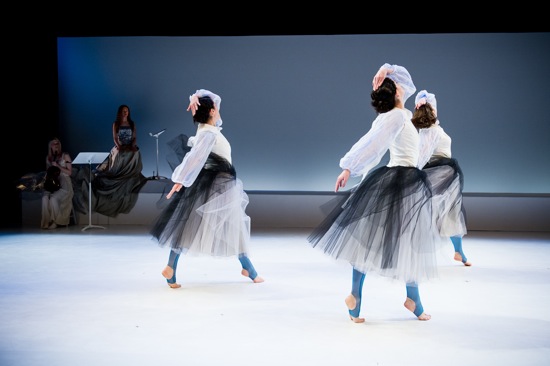
Three Giselles or wilis or monks. (L to R) Alexander, Lafferty, Clark. Rear: Pinky Weitzman (L) and Gelsey Bell. Photo: Ian Douglas
The gender complexities are dizzying. For one thing, Yokoshi shares the role of Hanako with a man, Kuniya Sawamura. Now consider this. In traditional Kabuki plays, men play all the roles. Shirabayoshi dancers were women (and sometimes courtesans), who performed as men portraying women. So, Yokoshi, a woman, plays a man performing a woman; Sawamura, a man, plays a woman playing a man performing a woman. This is piquant to think about whether you absorb the nuances or not.
Sawamura (who later plays a drum as well) enters before Yokoshi and the splendid Japanese musicians arrive; he performs a short solo that keeps him within a small area of light (the fine lighting design is by Roderick Murray). He wields a fan—open, closed, and, at one point, held between his teeth. His movements are refined; as he dips low, turning and bending, small adjustments take place in his body, and suspended pauses periodically break the flow. His steps—except for an occasional stamp—strike the floor softly. He introduces a movement that, in various ways, will occur in all succeeding solos. Something attracts his gaze high and to his left, and when the music ends, for a fleeting moment, his face shows a more shadowed expression, before resuming its sweet tranquility. In the Kabuki play, stage left is where the bell hangs.
Helped by the three women, Yokoshi ceremoniously dons the golden cap associated with shirabayoshi for her first dance (her gorgeous costumes are by Akiko Iwasaki). She, too, moves smoothly, but you can imagine subtle menace in the way her foot slides out from under her garment and her eyes narrow. At the end, she rushes to the left, as if to attack the invisible bell, then sinks to the floor.
It’s not possible to understand the nuances of the story, but we can see a different side of Hanako when Sawamura dances again. He/she appears happy, playful, more sinuous, slightly flirtatious (Sawamura is a marvelously subtle and adroit performer). Alexander, Clark, and Lafferty back him and, as Bell begins to sing “Bad Romance,” they join the “Ga-ga, ooh, la, la” choruses. The music-dance mixture becomes bizarre, both contending elements bound together by Bell’s theme of obsessive love.
If we could understand the words Kineya sings so beautifully, we might better understand Sawamura’s dance with a white towel; sometimes he holds the middle in his teeth and either end in his hands. Perhaps he is mourning; his face is sad. While he dances, the three women (now differently costumed) sit and copy his gestures. Bells clang. When Yokoshi enters again, she wears a white gown and wig (wigs and makeup by Koji Kasai (Upper Crust), and her lipstick has been wiped off, but we see no demonic triumph. Bell ends with a long, very understated solo by Keyo Seyama, an assistant for many years to Masumi Seyama VI. She is a small, slim woman wearing a plain kimono and no makeup. She too looks up to where the bell once hung and will hang again. She moves with great restraint and precision—nothing flashy, nothing overtly forceful. She is, I believe, exquisitely distilling for us the whole tale of desperate love and love beyond the grave. The verse that opens the Kabuki play (and which Yokoshi includes in the program) ends with this line about all women and the spiritual obstacles they face: “Her worries may be gone as the clouds clear up the sky/When gazing at the pure moon/ She might achieve enlightenment.”
I am not convinced that westerners will understand Kyôganoko Musume Dôjôji better because of Yokoshi’s linking it with the more familiar Giselle. I can, however, believe that the wish she expressed in the program could come true—that seeing Bell may make us want to seek out the Kabuki play, whether that means travelling to Japan or taking an arm-chair voyage via YouTube. In the meantime, watching the fascinating and richly enigmatic Bell is pleasure enough.

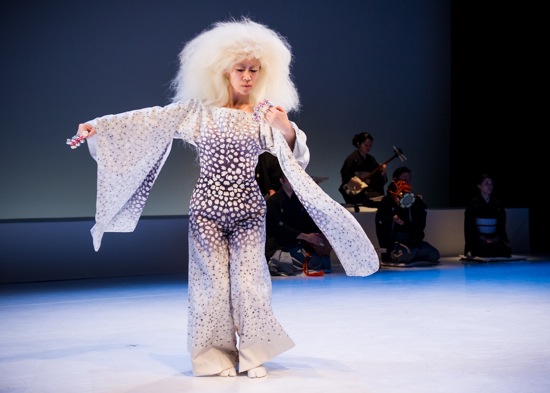
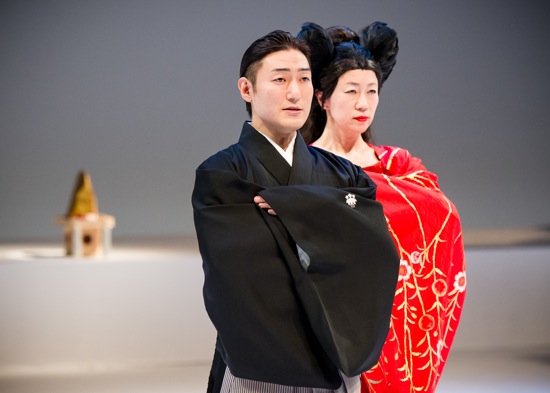
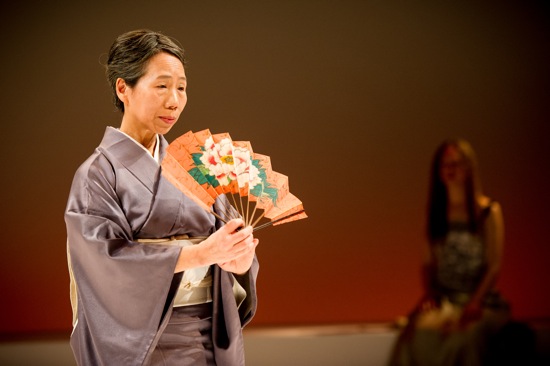
And reading this meticulously descriptive review of “Bell” offers its own pleasures, although my own long time fascination with the numerous ways the “twains” of East and West can meet in dancing, not to mention visual arts (think Rodin’s drawings of Cambodian dancers; the women of the turn of the last century who wanted desperately to go to Japan to study with master printmakers, my grandmother among them, makes me want terribly o see this work with my own eyes. I am as always grateful for the grace of your prose, Deborah.